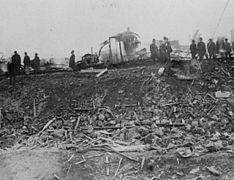Harrisburg Railway Accident
In the Harrisburg railway accident on May 11, 1905 near Harrisburg , Pennsylvania , USA , dangerous goods exploded after a derailment on a section of the Pennsylvania Railroad , killing 23 people.
Starting position
The Cincinnati Express was traveling east on the double-track line, a freight train in the opposite direction. The freight train carried 68 cars, but only some of the cars were equipped with brakes . A group of cars at the end of the train ran along without their own brakes. At Harrisburg, the train was signaled to “stop” because a locomotive was still shunting on the track in front of it. The engine driver braked.
the accident
When braking, the group of unbraked wagons ran into the braked wagons in front with such pressure that two of the braked wagons derailed and now protruded into the clearance profile of the opposite track. The Cincinnati Express drove into these cars without the collision itself resulting in personal injury. However, one of the freight cars was carrying 2.5 tons of dynamite , which exploded as a result of the collision .
consequences
23 people died. The first reports mentioned 163 deaths.
In response to this accident, among other things, the Explosives and Combustibles Act was enacted by the US Congress .
photos
Remarks
- ↑ So the information on the scene of the accident in the literature. The photo above, however, gives Lochiel , Pennsylvania, the scene of the accident, about 90 km north of Harrisburg.
See also
Individual evidence
- ^ A b Peter WB Semmens: Catastrophes on rails. A worldwide documentation. Transpress, Stuttgart 1996, ISBN 3-344-71030-3 , p. 26.
- ↑ Special To The New York Times: TRAIN HIT DYNAMITE; 163 REPORTED DEAD; . In: The New York Times . May 11, 1905 ( nytimes.com ).
- ↑ H. Dorias: Dangerous goods properties, handling, storage and transport. A textbook . Springer-Verlag, 1984, ISBN 978-3-662-07396-4 , p. 70.




